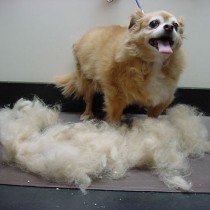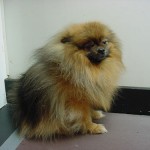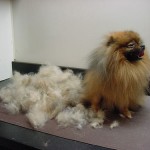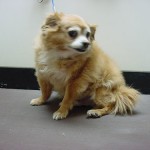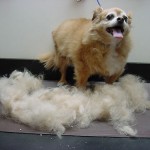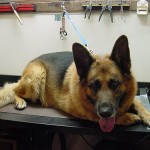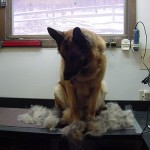The Truth About Shedding
When pet owners get together, they talk about both the joys and the trials of living with animals.
While the joys are many and varied, there’s one complaint that seems to be shared by all those who live under the same roof with a pet. The common complaint is one that both you and I are all too familiar with—shedding.
Let’s take an in-depth look at this “hairy” problem, and how I can help you solve it.
The Growth Cycle of Hair
As mammals, most breeds of dogs and cats share the glory of having hair. Hair serves multiple purposes for mammals. In the case of dogs and cats in particular, hair serves to insulate the animal from cold and heat, and is a source of protection and beauty.
Hair, by its nature, grows to a certain length that is predestined by the genetics of each particular mammal. Then, at some point, the hair falls out and is replaced with new hair. It is that falling-out process that causes the problem. So what are the mechanics behind hair growth and shedding?
Hair gets its start in the follicle. While human mammals normally have just one lonely hair per follicle, dogs have multiple hairs coming from each one. This is because canine follicles are “compound,” producing as many as 20 or more hairs from each follicular unit. Most breeds have a primary or “guard” hair, and then several secondary hairs.
Human tinkering and genetics have managed to create a wide diversity of coat types in dogs, from soft flowing coats like that of the Maltese to coarse coats found on some terriers. The variations are many, including the relatively hairless breeds, such as the Chinese crested, to breeds with amazingly dense coats like the chow chow.
No mater its density or texture, hair grows in distinct cycles:
- Anagen, the growth period.
- Catagen, the phase where the hair transforms from growth to resting.
- Telogen, the phase of inactivity.
- Expogen. The period when hair falls from the follicle.
Factors That Influence Shedding
Shedding is controlled by several different factors. Short-hair dogs, like the doberman I share my heart and home with, shed a lot. That is because it doesn’t take much time for their short hair to grow. Short hairs can complete their growth cycle in mere days or weeks.
Meanwhile, my toy poodle appears to not shed at all, because it can take literally years for her hair to grow from the follicle to its full length.
Then there are dogs like the rough collie. The hair on its muzzle and the front of its legs is very short. The hair on the top of its head is longer. Then there is that glorious big ruff, boasting hair that is long and flowing. All of this on one animal!
The lack of apparent shedding in poodles, bichons and other breeds has led to the myth that some breeds of dogs are “shed-less.” The truth of the matter is, where there is hair, there is shedding. Breeds of dogs that have a very long hair growth cycle do shed less than their short-haired counterparts, but shed they do.
Trimming a dog’s or cat’s coat short does not reduce shedding. The pet just sheds shorter hairs. In fact, very close clipping can disrupt the animals’ normal shed cycle.
And while we are myth busting, let me digress just a bit and say that dogs that shed less are not necessarily less likely to cause allergic reactions in humans. Human allergic reactions in dogs tends to be caused more by dander, saliva, urine and outdoor allergens trapped in the dog’s coat then to a specific coat type.
Besides the factor of predetermined genetic coat length, we also need to take into consideration seasonal shedding. In the spring, the thick coat the dogs grew in preparation for the cold season begins to shed out. This seasonal shedding is triggered less by the change in temperature than it is by the increased hours of daylight that pets are exposed to. This makes perfect sense—but why do dogs seem to shed so much in the shorter days of autumn? The answer is that they shed the lighter coat of summer to make way for the heavy winter coat.
Along with these very normal changes, individual pets’ shed cycles can be affected by their age, general nutritional status, hormonal factors, medication, parasites, illness or even stress. The condition of a dog’s skin and coat mirrors the overall health of the pet. A healthy, well-nourished animal will maintain its coat better than one that is infested, ill or not receiving appropriate nutrition.
Be aware that a pet that is shedding normally loses hair all over its body. While the coat may appear to be thinner overall, the appearance of especially thin or bald patches is not normal and calls for a visit to the veterinarian.
Thorough grooming will remove the bulk of hair that has already left the pet’s follicle, but pet owners may find that their dog is still shedding a good deal in the days following a visit to the groomer. This is because bathing, drying and brushing further stimulated coat that was about to shed to loosen its hold and join the process. Normally pet owner will notice a decrease in shedding several days after the grooming.
Before and after photos of dogs who’ve received a Carding grooming to remove excess hair
- Before carding to remove shedding
- After carding, with removed hair
- Before carding to remove excess hair
- After carding, with removed hair
- Before carding to remove excess hair
- After carding, with removed hair

